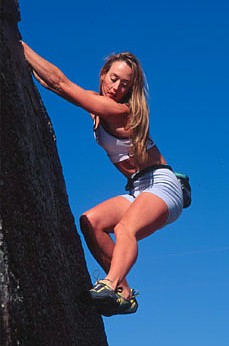Bouldering as Training For Climbing
 Bouldering is arguably the best all-around training for climbing since it targets all three areas of the performance triad (strength, technique, and the mind). Without the constraints of a belay and placing gear, bouldering allows you to narrow your focus onto the mission of climbing the hardest moves possible. What's more, steep boulder problems are a boon for developing upper body power as well as the vital core muscles of the torso. Add the camaraderie of a few friends and bouldering becomes a most gratifying experience.
Bouldering is arguably the best all-around training for climbing since it targets all three areas of the performance triad (strength, technique, and the mind). Without the constraints of a belay and placing gear, bouldering allows you to narrow your focus onto the mission of climbing the hardest moves possible. What's more, steep boulder problems are a boon for developing upper body power as well as the vital core muscles of the torso. Add the camaraderie of a few friends and bouldering becomes a most gratifying experience. Bouldering as a training method does have some limitations, however. First, the technical difficulties of a problem often prevent you from climbing until muscular failure (which is ideal for strength training). Furthermore, the wide range of different finger positions used on the typical boulder problem makes it unlikely that you’ll ever train a single grip position to failure. Of course, most of these "flaws" can be addressed by designing indoor boulder problems that isolate a specific grip, move, or arm position. (I’ll have more on this in a future posting).
As a conceptual model, consider outdoor bouldering as a valid method for training upper body power, technique, and a variety of mental attributes including tenacity, focus and the "killer instinct." Commence each bouldering session with a purpose whether it be to work just a few hard problems (to train power and maximum strength), send a series of moderately hard routes (to train anaerobic endurance), or climb specific routes that will train known technical weaknesses (skills practice). Each approach is equally valid, although most folks go bouldering with the purpose of working maximal routes. If this sounds familiar, strive to vary your approach to bouldering and you’ll become a better climber!
 Another key distinction for maximizing the "training effect" of bouldering is to focus on quality over quantity. Beating yourself up with a rapid-fire succession of attempts (and failures) or thrashing up a large number of known problems has marginal value—you might even "hard-wire” bad technique or incur an injury. Instead, make it a practice to rest more than you think you need to, and attempt each problem with the goal putting out your best effort (physically, mentally and technically). As a rule of thumb, rest for at least three minutes between attempts of short problems (6 hand moves or less), five to ten minutes for medium-length problems (7 to 15 hand movements), and ten to twenty minutes between burns on a most severe or ultra-long boulder problem.
Another key distinction for maximizing the "training effect" of bouldering is to focus on quality over quantity. Beating yourself up with a rapid-fire succession of attempts (and failures) or thrashing up a large number of known problems has marginal value—you might even "hard-wire” bad technique or incur an injury. Instead, make it a practice to rest more than you think you need to, and attempt each problem with the goal putting out your best effort (physically, mentally and technically). As a rule of thumb, rest for at least three minutes between attempts of short problems (6 hand moves or less), five to ten minutes for medium-length problems (7 to 15 hand movements), and ten to twenty minutes between burns on a most severe or ultra-long boulder problem. Finally, keep your sessions modest in length so as to not dig too deep a hole to recover from (or risk injury). Two to four hours of bouldering (using the above rest guidelines) is optimal. Until next time, send a few problems for me!
For more targeted training tips, visit the Nicros Training Center.
Photos: EH and Lauri Stricker bouldering in Colorado. Courtesy of StewartGreen.com



 Subscribe to Eric's RSS Feed
Subscribe to Eric's RSS Feed
 Subscribe to Eric's RSS Feed
Subscribe to Eric's RSS Feed